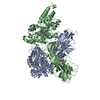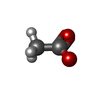+Search query
-Structure paper
| Title | A structured interdomain linker directs self-polymerization of human uromodulin. |
|---|---|
| Journal, issue, pages | Proc Natl Acad Sci U S A, Vol. 113, Issue 6, Page 1552-1557, Year 2016 |
| Publish date | Feb 9, 2016 |
 Authors Authors | Marcel Bokhove / Kaoru Nishimura / Martina Brunati / Ling Han / Daniele de Sanctis / Luca Rampoldi / Luca Jovine /    |
| PubMed Abstract | Uromodulin (UMOD)/Tamm-Horsfall protein, the most abundant human urinary protein, plays a key role in chronic kidney diseases and is a promising therapeutic target for hypertension. Via its bipartite ...Uromodulin (UMOD)/Tamm-Horsfall protein, the most abundant human urinary protein, plays a key role in chronic kidney diseases and is a promising therapeutic target for hypertension. Via its bipartite zona pellucida module (ZP-N/ZP-C), UMOD forms extracellular filaments that regulate kidney electrolyte balance and innate immunity, as well as protect against renal stones. Moreover, salt-dependent aggregation of UMOD filaments in the urine generates a soluble molecular net that captures uropathogenic bacteria and facilitates their clearance. Despite the functional importance of its homopolymers, no structural information is available on UMOD and how it self-assembles into filaments. Here, we report the crystal structures of polymerization regions of human UMOD and mouse ZP2, an essential sperm receptor protein that is structurally related to UMOD but forms heteropolymers. The structure of UMOD reveals that an extensive hydrophobic interface mediates ZP-N domain homodimerization. This arrangement is required for filament formation and is directed by an ordered ZP-N/ZP-C linker that is not observed in ZP2 but is conserved in the sequence of deafness/Crohn's disease-associated homopolymeric glycoproteins α-tectorin (TECTA) and glycoprotein 2 (GP2). Our data provide an example of how interdomain linker plasticity can modulate the function of structurally similar multidomain proteins. Moreover, the architecture of UMOD rationalizes numerous pathogenic mutations in both UMOD and TECTA genes. |
 External links External links |  Proc Natl Acad Sci U S A / Proc Natl Acad Sci U S A /  PubMed:26811476 / PubMed:26811476 /  PubMed Central PubMed Central |
| Methods | X-ray diffraction |
| Resolution | 2.251 - 3.2 Å |
| Structure data |  PDB-4wrn:  PDB-5bup: |
| Chemicals |  ChemComp-NAG:  ChemComp-ZN:  ChemComp-ACT:  ChemComp-HOH: |
| Source |
|
 Keywords Keywords | STRUCTURAL PROTEIN / ZP DOMAIN / EGF DOMAIN / EXTRACELLULAR MATRIX / GLYCOPROTEIN / CELL ADHESION / Sperm receptor / immunoglobulin-like domain / zona pellucida / protein polymerization |
 Movie
Movie Controller
Controller Structure viewers
Structure viewers About Yorodumi Papers
About Yorodumi Papers




 homo sapiens (human)
homo sapiens (human)
